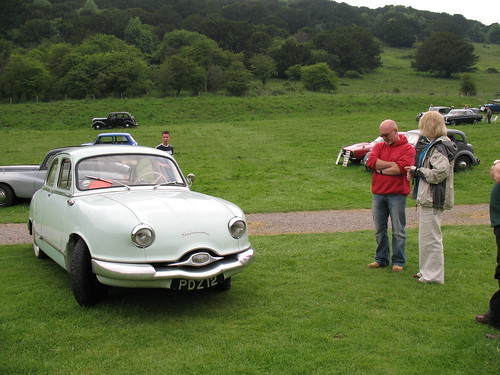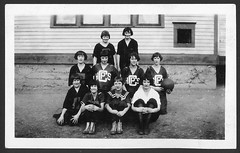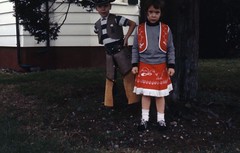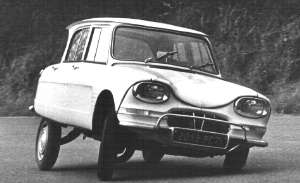I wrote this originally in an email to my cousin, who lives in Mexico, and doesn't understand "the bailout" issue very well. I don't understand it all that well either, but this is my take on what's happening, in what I hope is simple and straightforward language. Corrections welcome if I've mangled any economic truths here.
Here's the problem: modern economies run on credit. If the baker down the street wants to buy a new mixer so she can make more cookies, she goes to the bank and gets a loan. This is how ALL economic expansion works. Ultimately it goes back to the Federal Reserve, which loans to big banks, who loan to small banks, who loan to people to do stuff. You do the same thing when you take out a mortgage.
The loans are secured by the promise of value. If the bank thinks your house is worth the money, then your mortgage is safe and they'll loan it to you. Ditto the baker's mixer. The loan money is used by the person borrowing it to create some kind of value, and that value is partly used to pay the loan back. There's WAY more money outstanding in loans than anyone can pay back, because you're not expected to pay it all back NOW; you have years to pay it. During those years, you have to grow, or you won't be able to pay it back.
If the baker goes to the bank and the bank says "sorry, we can't loan you anything right now", the baker is screwed. They might say that because they think her business model is bad -- "these cookies taste like crap!", but they also might say that because THEY don't have any money.
This is all highly regulated. The amount banks can lend is tightly controlled, based on how much THEY have borrowed, which depends ultimately on how much the Fed wants to pump in. You might think the Fed could just pump in as much money as they wanted, and everybody'd have all the loans they want, but if those loans exceed the growth rate of the economy, you get inflation -- what they call "printing money". Your money is worth less, because there isn't anymore VALUE going around, just more dollars.
But there's another consequence of loaning too much: if they loan to people who can't pay, they don't get their money back. Remember that they've loaned way more than they actually have, and the banks have to pay their loans back too. Bad loans mean they can't pay, and banks fail. That's what's happening now; there isn't enough value in the country -- all the goods and services and so forth that we make -- to pay the loans. Banks are going tits up.
The problem that leads to is a "crisis in liquidity", which simply means there isn't any money available for new loans; it's all gone out to these bad loans, and the banks don't have enough money to pay their own bills, let alone loan out more. So nobody can get a loan for anything right now, not even good stuff like expanding a really successful business.
A liquidity crisis is bad in many, many ways. As I said, EVERYTHING in this economy depends on loans. Ultimately, that's where economic expansion comes from. Not just bakers buying mixers, but college students getting student loans -- virtually ALL college students today need loans. No loan, no college. That hurts the students, and it also hurts the colleges, which can't pay their bills.
Another example: durable goods. Not too many people go in and buy a car with cash; they get a loan. No loan = no car, which is bad for the car buyer but REALLY bad for the car maker, the dealer, the auto worker, the brake repairman, everybody. If you can't get mortgages, real estate agents and construction workers and carpet salesmen and furniture makers suffer. There are many examples.
So what happens is -- and this has happened MANY MANY TIMES in lots of economies around the world -- you have economic contraction instead of expansion, massive unemployment, government tax revenues fall, all these bad things. Everybody suffers.
So one possible way to forestall this is to bail out the banks.
That's what Congress is trying to do now. The problem is, bailing out the banks -- buying their bad loans so they can lend to good people again, paying off their debts, paying their depositors, etc. etc. -- means giving an absolute TON of money -- they're saying $700 billion but nobody really has any idea, it could be several times that -- to the very same people who got rich off all these bad loans in the first place.
To a lot of people, it looks like rewarding bad behavior. When the guy down the street can't pay his bills, they take his house; when the rich asshole on Wall Street can't pay his bills, he wants Congress to give him billions. That looks like a bad idea to a lot of people.
Unfortunately, there isn't any other choice. You NEED these banks to stay alive to keep the economy going. Without a bailout of some kind, we WILL have a major, major recession, contraction, maybe even a full-blown depression like we haven't seen in almost 80 years. It's by FAR the worst situation we've had in all that time. You just have to look at what happened in Japan during the "lost decade" to see how bad it can be -- we could easily be talking about massive, massive unemployment for ten years or more.
That hurts the entire world. Imagine what happens to Mexico's economy if (a) they are suddenly unable to sell anything to broke Americans; (b) stop having any tourists and (c) have all the migrants stop going to America because there's nothing there for them. In a fragile country like Mexico, a major depression in the US is going to cause a TON of poverty like you've never seen before, African poverty. But even strong economies like the UK, Canada, Germany, etc. will suffer.
Global depression is a bad thing. The people blocking the bailout now are doing so from an understandable position -- why should we bail out these rich assholes who have destroyed themselves -- but the consequences of not bailing them out will be EXTREMELY DIRE.
This is in fact what government is FOR -- floating us through a bad economic time. We used to have these episodes ALL THE TIME in the nineteenth century, but they were short; the Great Depression in the 1930s, though, was long, and something needed to be done, and FDR did it. In addition, all sorts of regulations were put in place to prevent this sort of thing from happening again. Unfortunately, the Republicans (with plenty of help from Democrats as well) have systematically gutted those regulations, so that we are in many ways right back where we were in 1929.
The thing is, these regulations DO hurt the economy a little. But they are NECESSARY; we give up a tiny bit of free expansion, but gain security, because the regulations prevent the economy from overheating and these markets from getting out of control. We can fix things when they break, or could; now we can't, and that's why we're in this fix.
What they SHOULD be doing is talking about rationalizing the deficit by raising taxes on the rich and putting some of the banking regulations like the Glass-Steagall provisions that were gutted in '98 back in place. But Congress is too stupid and pigheaded to do that. So the best we can hope for is this crummy bailout.
Yes, it's crummy, but it's necessary. That's what it boils down to. For once Bush is probably right. Ironically, now the House Republicans are against him. But they don't have any solutions of their own, just "NO!" They're like two year olds, really. Always have been, these damn Republicans.
Right now, it's a game of chicken. We need a bailout, but no one really knows how bad it's going to get without one, and everybody's just sort of waiting for one side to blink. I go back and forth; I think we can do a lot better deal than this one, but we have to do SOMETHING. Unlike the Republicans, I'm not willing to throw away the country for ten years just to spite these Wall Street jerks. Too many people are going to suffer.
ADDENDUM: I go back and forth on this one. I could be happy with this defeat if there was some indication that a better deal was coming. I absolutely do not agree that we can just let these banks fail; the people who would suffer most are not white-shoe Wall Street guys but everyone else, the ordinary people with their investments for retirement. And even more importantly, the forward motion of the economy.
A dead economy is going to have dire effects on lots of other things. Any chance at a rational energy policy, or workable health care, dies too.
But this bill? It stank. But we need something.























 I like booze. It's no secret. Love the stuff, and I've tried everything. When I go places I try to find exotic liquors, like the bottle of Suze (a gentian-and-vanilla flavored aperitif) I brought home from Paris, or the Xtabentun (Mayan honey-and-anise liquor) I enjoyed in Mexico.
I like booze. It's no secret. Love the stuff, and I've tried everything. When I go places I try to find exotic liquors, like the bottle of Suze (a gentian-and-vanilla flavored aperitif) I brought home from Paris, or the Xtabentun (Mayan honey-and-anise liquor) I enjoyed in Mexico. The cashew apple, as I also discovered today on
The cashew apple, as I also discovered today on  While poking around the web, though, looking for an online seller (whose deliveries would be illegal but unlikely to be traced or stopped) I did discover this Indian
While poking around the web, though, looking for an online seller (whose deliveries would be illegal but unlikely to be traced or stopped) I did discover this Indian 






















